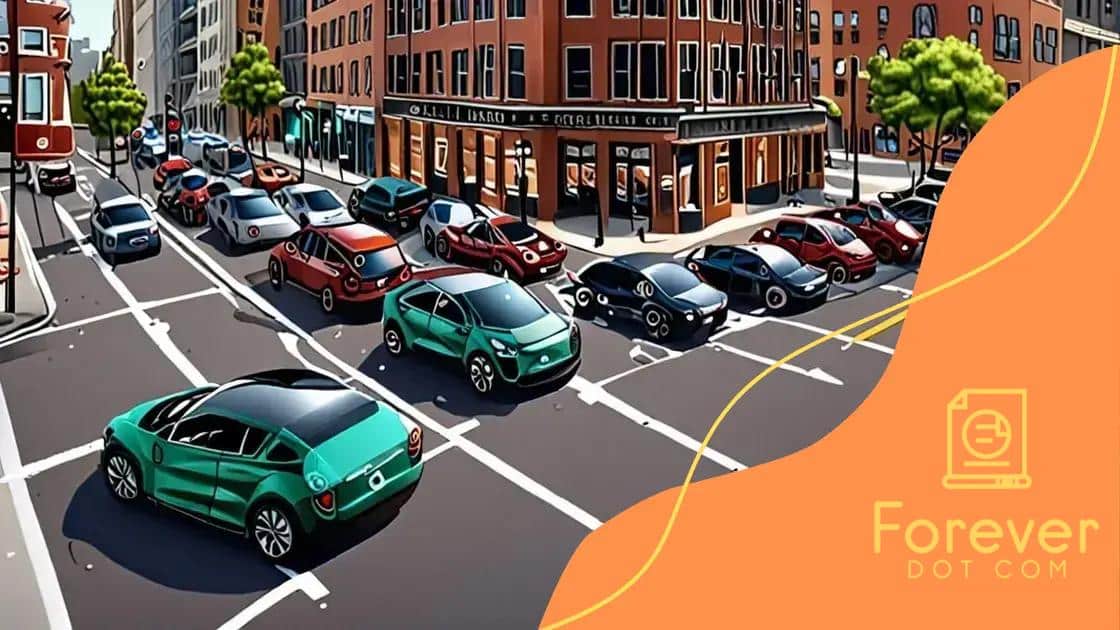The rise of electric cars and their impact on urban infrastructure

The rise of electric cars significantly impacts urban infrastructure by requiring enhanced charging networks, smarter city planning, and government support for sustainability initiatives, ultimately promoting cleaner environments and healthier communities.
The rise of electric cars and their impact on urban infrastructure is a topic that affects us all as cities evolve to accommodate new technologies. Have you thought about how these changes could reshape our daily lives?
Understanding electric cars and their popularity
Understanding electric cars and their popularity is crucial as we navigate a more sustainable future. Electric vehicles (EVs) are rapidly gaining traction worldwide due to their eco-friendly advantages.
One significant reason for the increasing interest in EVs is their environmental impact. These vehicles produce no tailpipe emissions, which greatly reduces air pollution in urban areas. As cities strive to improve air quality, electric cars are viewed as a pivotal solution in this battle for cleaner air.
Benefits of Electric Cars
Many people are drawn to electric cars for various reasons. Here are some key benefits:
- Cost savings: EVs often have lower operating costs than traditional gasoline vehicles.
- Incentives: Governments frequently provide tax rebates and incentives for EV purchasers.
- Convenience: Charging can often be done at home, making it easier for owners.
Moreover, advances in technology have made electric cars more appealing than ever. With ranges improving and charging times decreasing, more consumers are willing to make the switch. Major manufacturers are investing heavily in electric vehicle technology, leading to even more attractive options for buyers.
Another aspect to consider is the growing availability of charging infrastructure. As more charging stations become established in urban settings, the concerns about recharging EVs diminish significantly. These developments make owning an electric car not just a possibility, but a practical choice.
Community and Social Impact
The popularity of electric cars also fosters a sense of community. EV owners often share tips and experiences, helping others transition to this sustainable mode of transportation. Additionally, as awareness of climate change increases, more individuals recognize their role in creating a sustainable future.
In conclusion, understanding electric cars and their popularity highlights their role in the transition to a greener society. With environmental benefits, technological advancements, and improved infrastructure, it’s clear why electric vehicles are capturing the interest of consumers worldwide.
Infrastructure challenges in urban areas
Infrastructure challenges in urban areas are a significant concern, especially with the rise of electric cars. As cities adapt to this new wave of vehicles, various issues arise that must be addressed effectively.
One major challenge is the need for more charging stations. Many urban areas lack sufficient charging infrastructure, making it hard for EV owners to find convenient places to charge their vehicles. Expanding charging networks is essential for encouraging more people to switch to electric cars.
Grid Capacity and Energy Distribution
Another critical issue is the strain on the power grid. As more electric cars hit the roads, cities must ensure their energy distribution systems can handle the increased demand. Upgrading the grid is necessary to prevent outages and ensure reliable service.
- Upgrading infrastructure: Investing in modern technologies to support EVs is crucial.
- Smart grids: Implementing smart grid technology can help manage energy distribution efficiently.
- Renewable energy sources: Integrating renewable energy can reduce the carbon footprint of charging EVs.
Additionally, urban planning must evolve. Cities need to incorporate electric vehicle needs into their development plans. This includes designing roads and parking spaces that accommodate EVs and ensure easy access to charging stations.
Public transportation systems also face challenges. Cities must find ways to integrate electric vehicles into public transport while offering a reliable service to residents. This transition can lead to a more efficient and environmentally friendly public transportation system.
Investment and Policy Changes
Moreover, investment in this infrastructure is often hampered by budget constraints. Governments may need to rethink their priorities and allocate funds specifically for electric vehicle infrastructure. Policy changes can encourage private investments, creating a more extensive network of charging stations and supporting infrastructure.
In conclusion, addressing these infrastructure challenges is vital for urban areas to successfully integrate electric cars. By tackling issues like charging station availability, grid capacity, and urban planning, cities can pave the way for a sustainable future.
Benefits of electric vehicles for communities

The benefits of electric vehicles (EVs) for communities are significant and can lead to a more sustainable way of living. Electric vehicles not only provide environmental advantages but also enhance the quality of life for residents.
One of the most notable benefits is the reduction in air pollution. Electric cars produce zero tailpipe emissions, which can help improve air quality in urban environments. This is especially important for cities that struggle with smog and other pollutants.
Economic Advantages for Communities
Additionally, the adoption of electric vehicles can create economic opportunities. Communities can benefit from the growth of local charging infrastructures, like stations placed in shopping centers or public garages. These installations often lead to increased foot traffic, which can boost business in the area.
- Job creation: New jobs are generated in installing and maintaining EV charging stations.
- Lower energy costs: EVs can often be charged at lower costs than gasoline vehicles.
- Attracting investment: Areas with extensive EV infrastructure can attract eco-conscious businesses and residents.
Moreover, electric vehicles contribute to energy independence. By encouraging the use of renewable energy sources for charging, communities can reduce their reliance on fossil fuels. This shift not only helps the environment but also stabilizes energy prices over time.
Social benefits also arise from adopting electric vehicles. Many communities establish car-sharing programs that include electric cars. These programs make EVs accessible to those who may not be able to afford them individually, fostering inclusivity.
Improving Public Health
Furthermore, the reduction of greenhouse gas emissions leads to improved public health. A cleaner environment means fewer health issues related to air quality, such as asthma or respiratory diseases. Communities that prioritize EV adoption are investing in their residents’ well-being.
Overall, the benefits of electric vehicles for communities weave together environmental, economic, and social threads. Embracing this technology not only helps tackle climate change but also fosters a thriving local economy and a healthier, happier populace.
The role of government in supporting EV adoption
The role of government in supporting EV adoption is crucial to creating a sustainable transportation future. Without strong support, the transition to electric vehicles could face numerous challenges.
One primary way that governments help promote EV adoption is through incentives. These financial benefits include tax credits and rebates for consumers who purchase electric vehicles. Such incentives make it more affordable for individuals and businesses to switch to EVs.
Infrastructure Development
Another significant aspect of government support involves investing in charging infrastructure. By funding the installation of public charging stations, governments can alleviate range anxiety and encourage more people to consider electric cars. This infrastructure development ensures that charging points are accessible in urban and rural areas alike.
- Public transportation electricification: Governments are also working to electrify public transport systems, reducing emissions and improving air quality.
- Grants for companies: Providing grants to companies that develop EV technology and infrastructure can stimulate innovation and reliability.
- Collaborative planning: Local governments often collaborate with businesses and communities to create effective EV strategies.
Furthermore, regulations play a vital role in shaping the EV landscape. Governments can implement policies that encourage the use of electric vehicles, such as emission standards and mandates for a percentage of new vehicles sold to be electric. These regulations push manufacturers to produce more electric options while encouraging consumers to make the switch.
Educational campaigns also serve as a government tool in promoting EV adoption. Informing the public about the benefits of electric vehicles and how to make the transition can alleviate misconceptions and increase acceptance. When communities understand the advantages of EVs, they are more likely to embrace these changes.
Long-term Sustainability Goals
Moreover, governments are increasingly aligning their transportation policies with broader sustainability goals. By setting targets for carbon emissions reduction, states and municipalities are committing to a greener future, where electric vehicles play a central role. This commitment not only benefits the environment but also supports public health by reducing pollution.
The role of government in supporting EV adoption is multi-faceted and essential for a successful transition to a cleaner transportation system. By providing incentives, developing infrastructure, and implementing supportive policies, governments can pave the way for a future powered by electric vehicles.
Future trends in urban planning with EVs
Future trends in urban planning with electric vehicles (EVs) indicate a significant shift in how cities will develop. As the adoption of EVs increases, urban planners are rethinking their strategies to create more sustainable environments.
One main trend is the integration of EV charging infrastructure into new developments. Future urban areas will likely see charging stations placed in residential neighborhoods, commercial centers, and near public transportation hubs. This will ensure residents have easy access to charging, making the transition to electric vehicles more convenient.
Smart City Innovations
Additionally, smart city technologies will play a crucial role in supporting electric vehicles. Cities will adopt smart grids that can handle the increased energy demand from EVs. These grids can also optimize energy distribution, ensuring that charging stations are accessible and efficient.
- Dynamic pricing: Charging costs may vary based on energy demand, encouraging EV users to charge during off-peak hours.
- Integration with renewables: Future urban areas will use renewable energy sources, reducing the carbon footprint of charging stations.
- Data-driven planning: Planners will use data analytics to understand charging patterns and optimize the placement of EV infrastructure.
Moreover, as cities aim for sustainability, they will encourage mixed-use developments. These areas will have residential, commercial, and recreational facilities close together, reducing the need for long drives. This layout not only supports the use of EVs but also promotes walking and biking, further reducing emissions.
Urban designs will likely include dedicated lanes for electric and shared mobility options, making it easier for residents to choose electric transportation. Zoning laws may evolve to require new buildings to include EV charging capabilities, making them more adaptable to future needs.
Public Transportation Evolution
In addition, public transportation systems will increasingly adopt electric buses and vehicles. This shift can significantly reduce pollution in city centers and provide more eco-friendly transport options for residents. Planning for these changes includes investing in charging stations specifically for public transport vehicles.
Overall, future trends in urban planning with EVs signal a more sustainable and efficient approach to city living. By integrating electric vehicles into the core of urban design, cities can create healthier, more accessible environments for everyone.
FAQ – Frequently Asked Questions about Electric Vehicles and Urban Planning
What are the main benefits of electric vehicles for communities?
Electric vehicles reduce air pollution, improve public health, and can boost local economies through the development of charging infrastructure.
How does government support influence EV adoption?
Governments provide incentives, invest in charging infrastructure, and implement regulations that encourage the use of electric vehicles.
What role does urban planning play in the adoption of electric vehicles?
Urban planning integrates EV charging stations and promotes mixed-use developments, making electric vehicles more accessible and convenient for residents.
What future trends can we expect in urban planning related to electric vehicles?
Future trends include the integration of smart city technologies, increased focus on renewable energy, and the expansion of EV infrastructure in neighborhoods.






